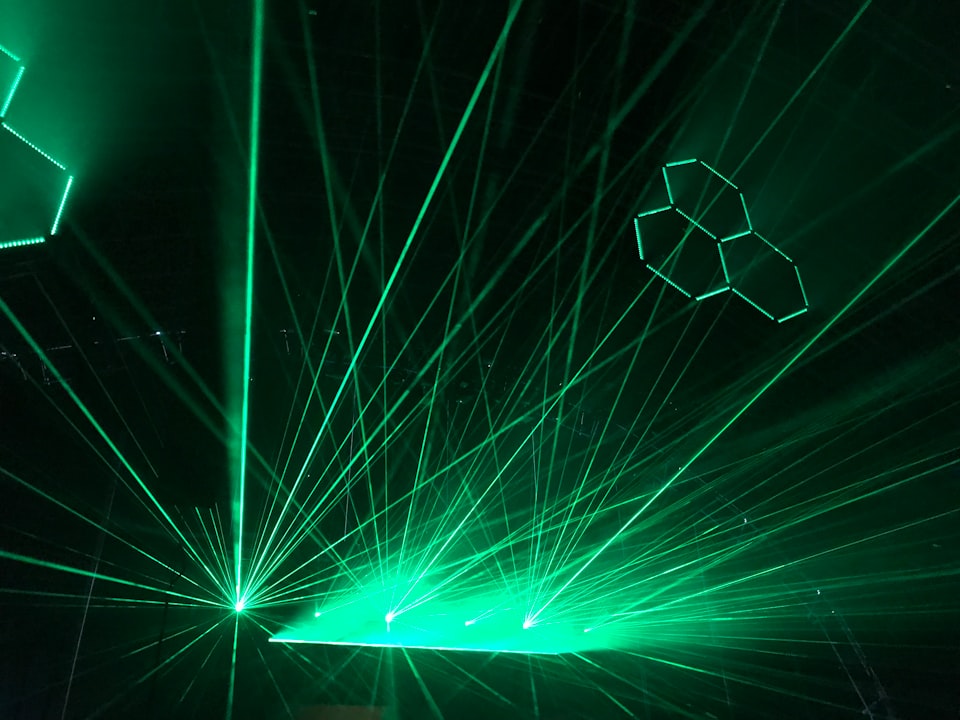Lasers

Lasers are really cool.
They're even cooler when you can use them to do medical stuff, largely because it's a legitimate excuse to play with lasers.
Podcast episode
Take home messages
- Unsurprisingly, anything firing vast quantities of energy in a single direction can be dangerous
- You need to know the necessary precautions for preventing laser-induced problems, and how to manage these problems when they do occur
You need to know this
Because lasers use science, and you're an anaesthetist, you need to know how they work.
Indications for using a laser
Lasers can cut, burn and coagulate all at once, making them very useful for precision surgery.
Currently the common indications are:
- Central airway tumours (bronchogenic carcinoma)
- Vocal cord tumours
- Endometriosis
- BPH
- Skin lesions
- Ureteric stones
- Tattoo removal
As with all of the hazardous tools we use in theatre, it's good practice to appreaciate how the equipment can interact with:
- The patient
- The staff
- Other equipment
Some definitions first
Laser stands for light amplification by stimulated emission of radiation.
You will be asked this at least five times between now and consultancy.
Laser light has the following properties:
- Monochromatic (only one colour)
- Collimated (the beam doesn't diverge or converge)
- Coherent (all of the photons are in phase with one another)
The energy of the laser radiation is:
E = hv
- E = Energy of the photons
- h = Planck's constant
- v = Frequency
Therefore you can see that the frequency is the only variable that directly affects the energy of the laser light's beam.
How lasing works
If you excite an electron - by firing radiation at it, or informing it that the next case might require an awake fibreoptic intubation - then it jumps up an energy level.
If left alone, it will then drop back down an energy level, and release that energy as a photon.
If you have a whole population of these electrons, in what's known as a lasing medium, you can hit them all at once with an external energy source such as a flashing light or a high voltage.
Then by putting reflectors at either end, you can have these photons fire back and forth throughout the lasing medium, exciting more electrons as they go.
This process is called 'pumping'.
Once you have lots of electrons all being 'pumped' in this manner, you get a rapid and dramatic amplification of this process, resulting in lots of light energy being produced all at once.
Once there are more electrons in the excited state than the relaxed state, the medium is said to 'lase'.
Then you fire the resulting beam of light out of a small hole.
A spot of History
Albert Einstein mentioned the possibility of a laser back in 1917, but the first functioning example was only put together in 1960 Theodore H. Maiman.
Einstein had figured out that if you hit an electron with a photon, and then let it relax back to its original energy state (emitting another photon in the process) then you end up with two photons of equal frequency that are in phase.
This means the peaks and troughs of the individual waves all line up in space and time with one another.
He therefore deduced that you could amplify this process very quickly, producing an intense beam of emitted light.
Different types of laser
Lasers are usually described in terms of their lasing medium
Solid state
Ruby
- Aluminium oxide with 0.05% chromium ions giving the beautiful red colour
- The chromium ions are key here - the applied energy source, usually in the form of a flashing light, pumps the chromium ions, emitting the required photons.
Nd-YAG
- Neodymium doped yttrium/aluminium Oxide
- 1060nm - infrared
- Good tissue penetration (2-6mm)
- Used for cutting and coagulation in surgery and endoscopy
- Best for airway surgery
Semiconductor
Gallium Arsenide (GaAs)
- Low power output, very efficient - used in DVDs
- Not used clinically
Liquid
Yellow pulsed dye
- Wavelength of 390-640nm
- Used for dermatology
- Birthmark removal and cutaneous vascular lesions
Mixtures of organic dye molecules can be pumped using other high power lasers. Then a diffraction grating at one end of the laser can select out the wavelength that you want.
Gas
Helium-neon
- 90% helium and 10% neon
- The helium atoms become excited by a large electrical voltage (who wouldn't?) and then transfer energy to the neon atoms.
- The neon atoms then emit laser light at 633nm (red)
Carbon dioxide
- Used for superficial surgery and coagulation
- Very poor tissue penetration
- 10600 nm - infrared
Argon
- 480-500 nm - blue green
- Used in retinal coagulation and dermatology
- Best for eye surgery as it penetrates transparent tissues well
Safety First
A high energy beam of light focused onto a very small area can cause retinal damage, burns and fires.
- Moving further away doesn't really help, because the beam is collimated and therefore doesn't spread out
- The light can be reflected by shiny surfaces, of which there are many in an operating theatre
- Infrared light can cause corneal and lens damage in particular
How are laser products classified?
Lasers are classified based upon how dangerous they are to human health.
These are the definitions according to the international classification of continuously working lasers.
Class 1
- Power not to exceed maximum permissible exposure for the eye, or safe because of engineering design
Class 2
- Visible laser beams only (400–700 nm)
- Powers up to 1 mW
- Eye protected by blink-reflex time of 0.25 s
Class 2m
- As Class 2, but not safe when viewed with optical aids such as eye loupes
Class 3a
- Relaxation of Class 2 to 5 mW for radiation in the visible spectrum (400–700 nm) provided the beam is expanded so that the eye is still protected by the blink-reflex
- Maximum irradiance must not exceed 25 W m–2 for intrabeam viewing
- For other wavelengths, hazard is no greater than Class 1
Class 3b
- Powers up to 0.5 W
- Direct viewing hazardous
- Can be of any wavelength from 180 nm to 1 mm
Class 4
- Powers over 0.5 W. Any wavelength from 180 nm to 1 mm
- Capable of igniting inflammable materials.
- Extremely hazardous
You don't need to be able to recite this information in an exam, you just need to appreciate there are different levels of risk.
Airway fires
If the surgeon is using the laser inside the patient's ureter to break up a stone, then hopeful the risk of an airway fire should be fairly minimal. However once we start talking about laser surgery in the airway, the risk becomes very real indeed.
Fires need oxygen, fuel and a source of ignition - all of which are conveniently present in the patient's mouth during laser surgery.
Hence it is rather important to mitigate this risk as far as possible.
How can you minimise the risk of an airway fire?
- Reduce FiO2 as low as possible (below 25%)
- Avoid Nitrous oxide
- Non-reflective matt coated surgical equipment
- Laser-safe endotracheal tubes
- Wet swabs to protect nearby tissues
What to do if there is a fire
- Turn the laser off
- Flood the area with saline
- Disconnect the breathing circuit
- Extubate the patient
- Facemask ventilate the patient using air
- Ensure fire extinguished
- Rigid bronchoscopy to examine for damage and re-intubation as required
- Admit to intensive care
- Dexamathasone to reduce airway swelling
- Re-bronchoscopy after 48-72 hours
Syllabus
- PC_BK_57 Lasers: basic principles and safety
Tap the image for a free CRQ from FRCA-revision.com

If you'd like to read the poem that we asked ChatGPT to write about managing an airway fire, click here
Useful Tweets and Resources
Review Question of the Day for today: Airway fires and laser safety. Test yourself: https://t.co/MRbAM1fnnh
— OpenAnesthesia® (@openanesthesia) November 18, 2015
Airway surgeons/anaesthetists that are using lasers on THRIVE (or jet ventilation):
— Liz Ross (@lizrossauc) March 23, 2022
Please could I pick your brains about settings/FiO2/strategies you utilise to reduce airway fire risk etc… and maybe even arrange to visit as a team to learn from those that do this regularly!
20mm Stone in obese female patient and Hb 8g!!! PCNL not the best option… Perfomance RIRS with high power láser TIVA anesthesia NO TOUCH-DANCING & PAINTING ❌ BASKETING #urosome #endourology #urology @Innovexmedical @PromedonEndouro @equifarm_ec pic.twitter.com/06hW9enBbT
— Alfredo Sanchez Urólogo (@lfredosanchez) September 25, 2021
References and Further Reading


Primary FRCA Toolkit
Members receive 60% discount off the FRCA Primary Toolkit. If you have previously purchased a toolkit at full price, please email anaestheasier@gmail.com for a retrospective discount.

Discount is applied as 6 months free membership - please don't hesitate to email Anaestheasier@gmail.com if you have any questions!
Just a quick reminder that all information posted on Anaestheasier.com is for educational purposes only, and it does not constitute medical or clinical advice.
